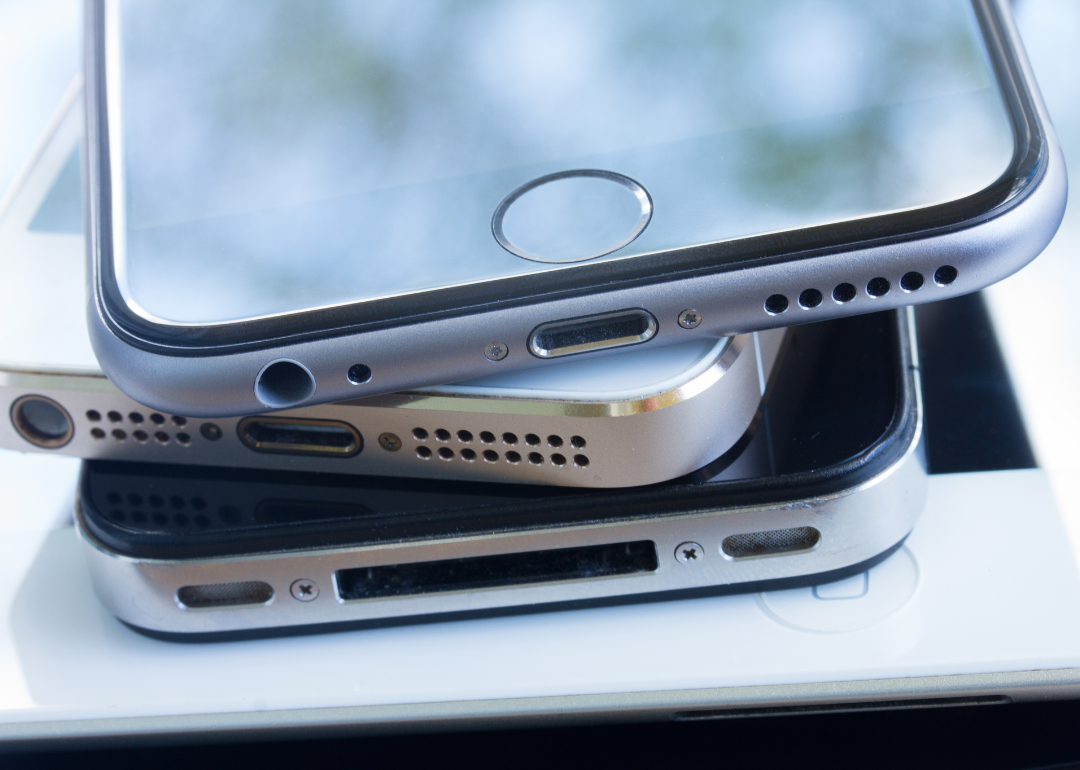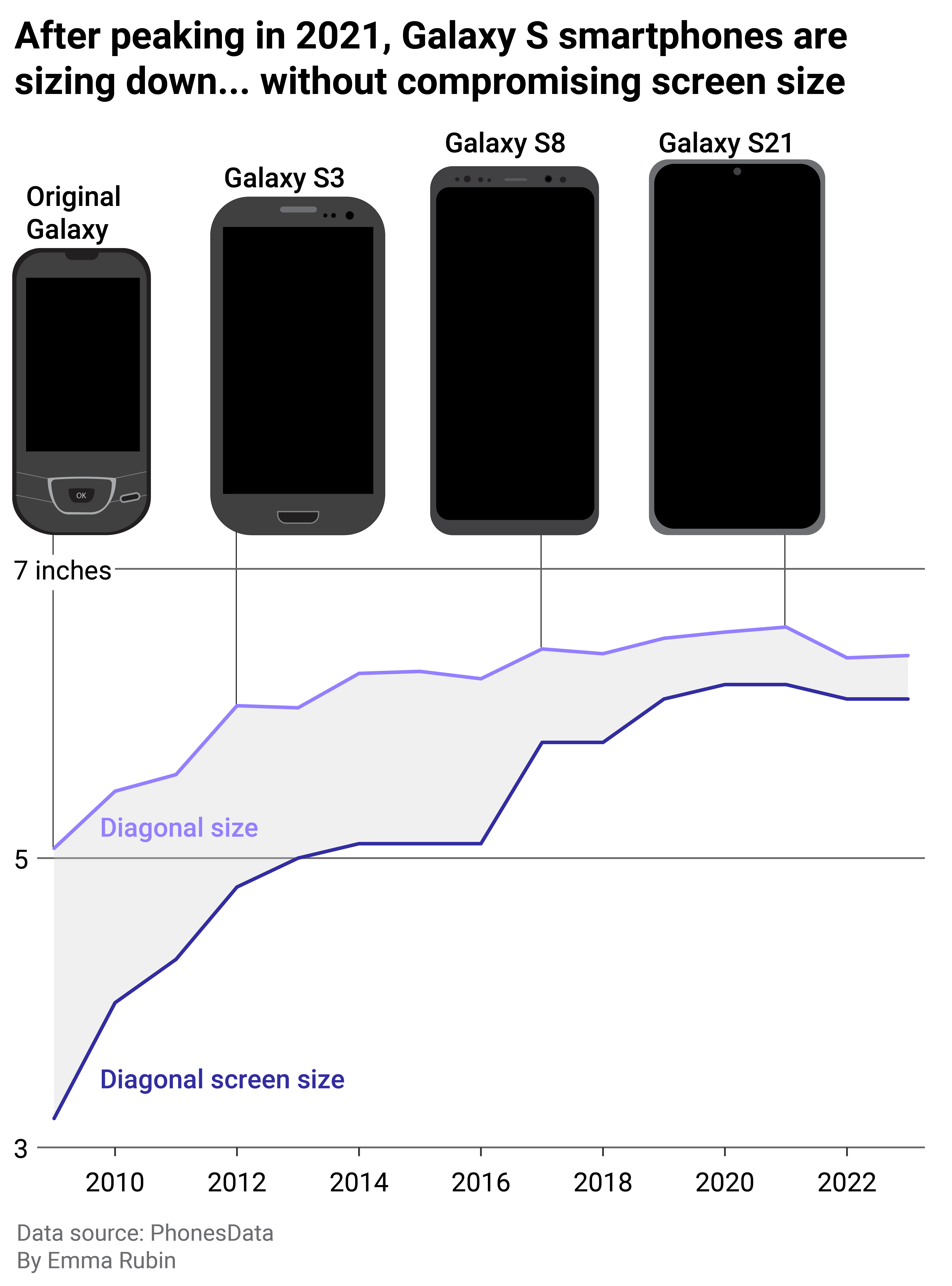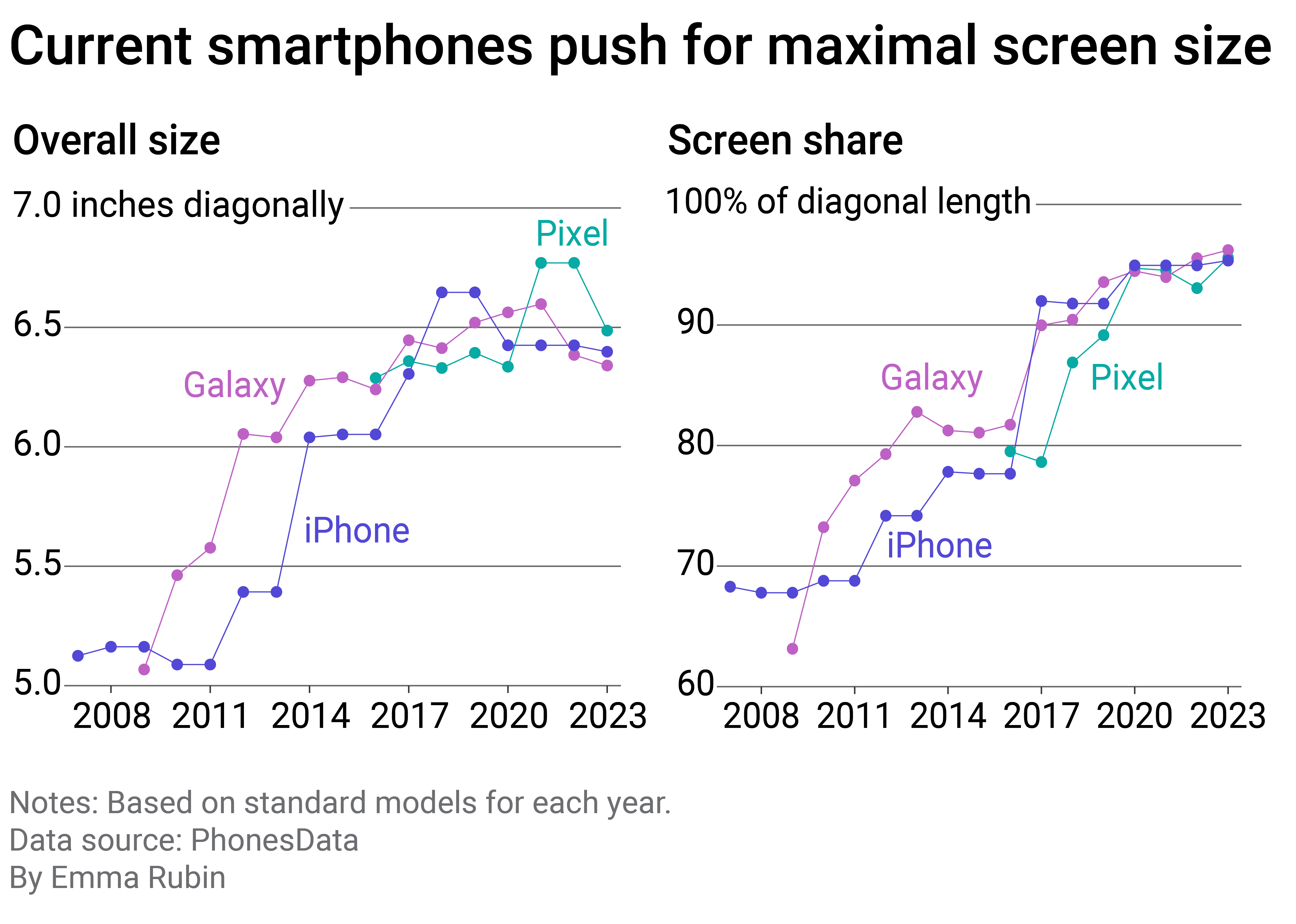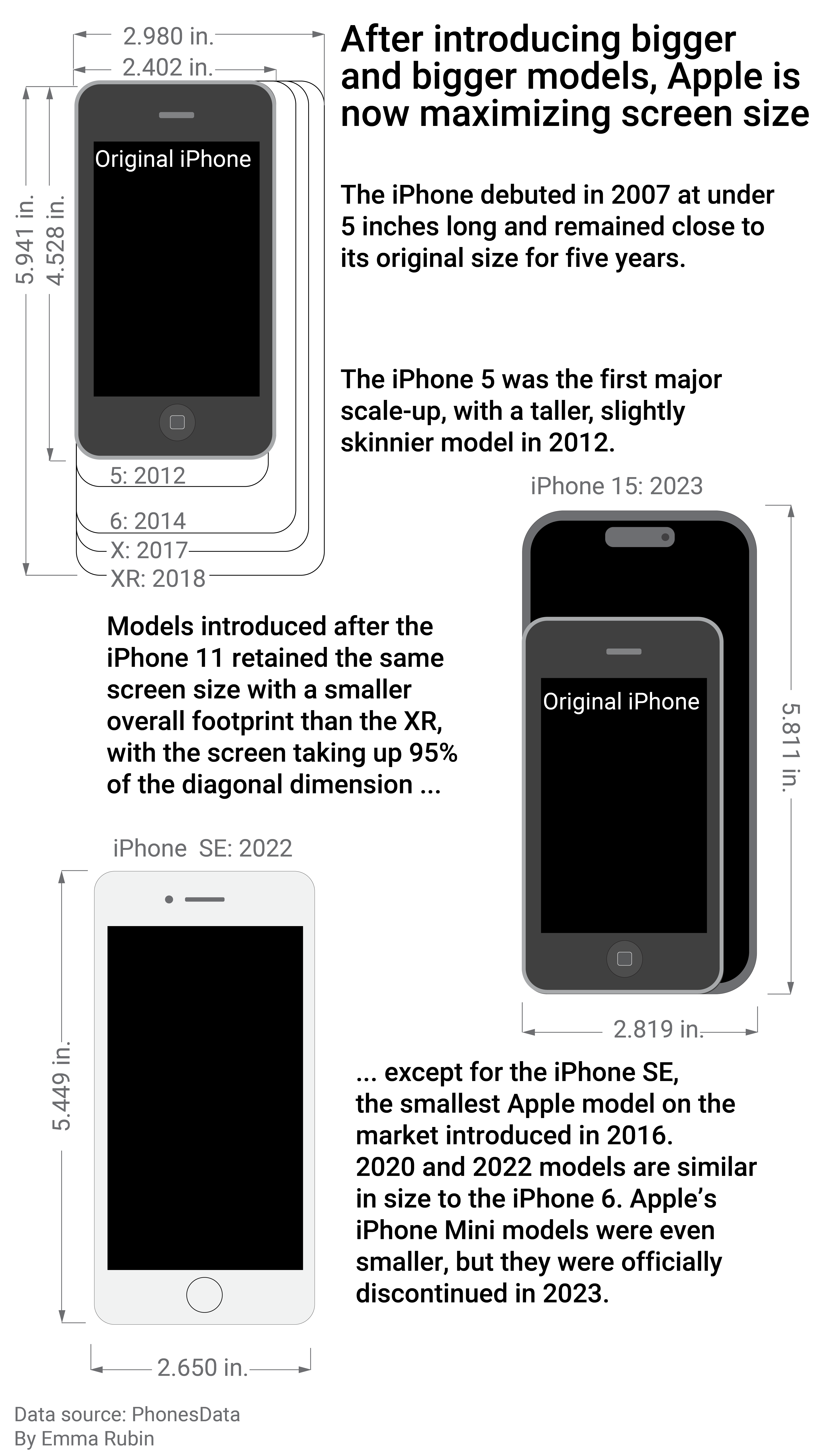Smartphones used to be half the size they are today—here's how they've grown in size over time

Zhang Peng // LightRocket via Getty Images
Smartphones used to be half the size they are today—here’s how they’ve grown in size over time
A close-up of a stack of smartphones on a desk.
Pacing back and forth on an auditorium stage in his signature black turtleneck and blue jeans, Steve Jobs addressed members of the media one mid-July morning in 2010.
Apple’s chief executive was responding to reports that consumers were having their phone calls dropped when using the latest device, the iPhone 4. The company had found a way to incorporate the cellular antenna into the stainless steel frame of the phone, saving precious real estate. But some wanted to know: Why not just make the phone slightly bigger, as its rivals had?
“No one’s going to buy that,” Jobs replied.
The tech oracle credited with bringing smartphone technology into the 21st century had strong opinions. Chief among them was a belief that the American consumer did not actually want a phone so large it couldn’t fit in the palms of their hands.
Jobs was focused on building the best cellphone on the market at a time when other manufacturers were focused on adding cameras, games, and other functionality he felt detracted from the devices.
Was Jobs wrong? This year’s slate of updates to smartphone lines from Google, Apple, and Samsung and the consumer demand for them in recent years may suggest so.
One thing is growing more certain with each model year introduced to the public—smartphones aren’t getting much smaller. Especially now that Apple has officially dropped the iPhone Mini, one of the last small-sized smartphones with high-end internals, from its lineup this fall.
Today’s flagship Apple smartphone, the iPhone 15, covers a 51% larger surface area and is 27% heavier than the original iPhone. Samsung’s flagship Galaxy smartphone area has grown 60% larger, its weight 45% heavier. Google’s flagship Pixel line currently offers the heaviest flagship phone among top U.S. manufacturers on the market. Since joining the market in 2016, the line of phones has put on a solid 44 grams, making it 31% heavier than the original Pixel, and now features a 7% larger screen than when it debuted.
Stacker compiled smartphone specs from PhonesData for the bestselling device makers in the U.S. to illustrate how our phones have grown ever larger over the last two decades.
![]()

Emma Rubin // Stacker
Samsung’s Galaxy line of phones sees most dramatic upsizing
Chart showing how Galaxy smartphones have sized down since 2010.
Samsung’s flagship Galaxy series launched in 2010 and leaned into larger phone sizes that accommodated better hardware, even if it meant pushing the phone size a little wider, taller, or thicker before Apple was comfortable doing the same. The initial few Galaxy S series phones featured more robust specs on paper, making Apple’s popular operating system and thriving third-party app store some of the company’s biggest differentiators 10 years ago.

Emma Rubin // Stacker
Android handsets push hardware
Two charts showing how overall phone size and screen share have changed for Pixel, Galaxy, and iPhone phones since 2008.
Initially, Samsung’s larger-sized phones helped accommodate more advanced camera technology, larger screens, and screaming-fast processors. It ran a proprietary version of the open-source Android software acquired by Google in the mid-aughts. Samsung’s willingness to push the boundaries of ergonomics and lean into the phone as a general-purpose entertainment device served it well in terms of sales.
In the subsequent years, Apple followed Samsung’s lead, increasing the size of the touch screens it made available to customers. The devices the company’s founder once annoyingly described as the “Hummers” of smartphones, in hindsight, are now its true north.
Google itself had released a few smartphones of its own as the smartphone competition heated up. Ultimately, though, the company struggled to compete in the early 2010s. It experimented with a phone dubbed the Google Nexus, which was manufactured by HTC and lacked multi-touch controls. The Nexus line was discontinued in 2016.

Emma Rubin // Stacker
Apple’s waning interest in small phones
Graphic showing how Apple has maximized screen size since the iPhone debuted in 2007.
First revealed to the public in September 2014, the Apple iPhone 6 became the handset manufacturer’s biggest departure from Jobs’ ethos of ergonomic smartphones. Even still, the iPhone 6 is also the company’s bestselling phone of all time. Where the iPhone 5 was sold as a phone your thumb could reach every corner of, the iPhone 6 was the first in the iPhone lineage to split models into a standard and plus size.
And the small smartphone could become a relic for Apple.
In the aftermath of Apple’s latest device reveal in September, observers quickly pointed out the lack of a smaller version of its smartphones. Apple dropped the “mini” from its lineup in 2022 and didn’t bring it back this year. The company’s budget model that doesn’t typically include the latest and greatest hardware, the iPhone SE, is rumored to get a refresh in the next year or two. For now, it may be consumers’ only compact option.
However, how long it will last in the lineup is anyone’s guess. Bloomberg has previously reported that Apple’s more expensive, high-end flagship model, the iPhone 14 Pro, saw more demand than the entry-price iPhone SE.
![]()
Emma Rubin // Stacker
Have we hit the sweet spot?
Graphic showing how much larger the Google Pixel 7 is compared to the iPhone 14 and Galaxy S23.
Studies performed over the years have tried to ascertain the most ergonomic shape and size for a device intended to be navigable with just one human hand. While phone screens have grown, their operators’ hands have not. And the reach of one’s thumb generally dictates whether a phone screen will serve them well, experts have found. Bigger is not always better.
But at least one study funded in part by the National Science Foundation suggests even the size of the 3-inch iPhone 3G was never all that ergonomic unless used with both hands.
Google’s latest flagship phone, the Pixel 8, now stands over its competitors, while Samsung and iPhone have slowed the expansion of their flagship phone sizes. Instead, each has begun issuing separate larger model sizes, with Apple branding its plus-sized line the “Pro Max” line.
Samsung offered the large Galaxy Note series, ultimately rebranded as the “Ultra” version of its Galaxy S line, now in its 14th edition. Samsung was also the first major handset maker in the U.S. to venture into the nascent foldable smartphone market. Google has now released its own folding-style phone, dubbed the Pixel Fold.
The new devices attempt to split the difference by allowing consumers to transform the tablet-sized screen into something half as wide and twice as thick. However, demand for the modern twist on the classic flip phone has been hard to gauge. Despite statements from Samsung characterizing sales growth as positive for its foldable phones, some analysts point to high prices as a consumer barrier. Meanwhile, the global market for foldable phones has grown over the last year, while the overall smartphone market has shrunk.
Data reporting by Dom DiFurio and Emma Rubin. Story editing by Jeff Inglis. Copy editing by Paris Close. Photo selection by Elizabeth Ciano.